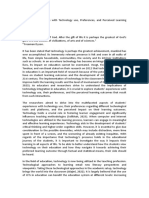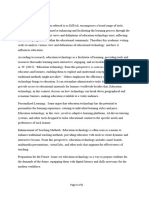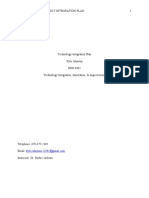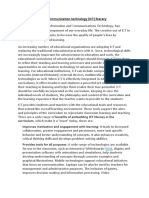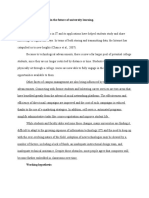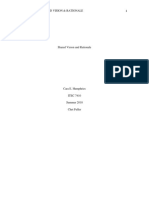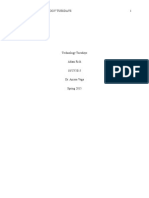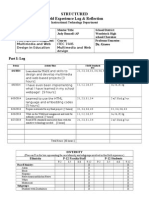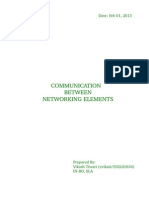0 ratings0% found this document useful (0 votes)
92 viewsVision Paper
Vision Paper
Uploaded by
api-290871487The document presents a vision for integrating technology into classrooms at Woodstock High School to improve student learning and engagement. The vision is to use technology to flip classes and incorporate constructivist learning methods. This will involve training teachers to select technologies that support student learning objectives and higher-order thinking skills. It also aims to improve communication between the school, parents, and community about the technology implementation and changes. Regular reflection on how technology impacts student outcomes is part of holding teachers accountable for effective technology use.
Copyright:
© All Rights Reserved
Available Formats
Download as DOCX, PDF, TXT or read online from Scribd
Vision Paper
Vision Paper
Uploaded by
api-2908714870 ratings0% found this document useful (0 votes)
92 views5 pagesThe document presents a vision for integrating technology into classrooms at Woodstock High School to improve student learning and engagement. The vision is to use technology to flip classes and incorporate constructivist learning methods. This will involve training teachers to select technologies that support student learning objectives and higher-order thinking skills. It also aims to improve communication between the school, parents, and community about the technology implementation and changes. Regular reflection on how technology impacts student outcomes is part of holding teachers accountable for effective technology use.
Original Title
vision paper
Copyright
© © All Rights Reserved
Available Formats
DOCX, PDF, TXT or read online from Scribd
Share this document
Did you find this document useful?
Is this content inappropriate?
The document presents a vision for integrating technology into classrooms at Woodstock High School to improve student learning and engagement. The vision is to use technology to flip classes and incorporate constructivist learning methods. This will involve training teachers to select technologies that support student learning objectives and higher-order thinking skills. It also aims to improve communication between the school, parents, and community about the technology implementation and changes. Regular reflection on how technology impacts student outcomes is part of holding teachers accountable for effective technology use.
Copyright:
© All Rights Reserved
Available Formats
Download as DOCX, PDF, TXT or read online from Scribd
Download as docx, pdf, or txt
0 ratings0% found this document useful (0 votes)
92 views5 pagesVision Paper
Vision Paper
Uploaded by
api-290871487The document presents a vision for integrating technology into classrooms at Woodstock High School to improve student learning and engagement. The vision is to use technology to flip classes and incorporate constructivist learning methods. This will involve training teachers to select technologies that support student learning objectives and higher-order thinking skills. It also aims to improve communication between the school, parents, and community about the technology implementation and changes. Regular reflection on how technology impacts student outcomes is part of holding teachers accountable for effective technology use.
Copyright:
© All Rights Reserved
Available Formats
Download as DOCX, PDF, TXT or read online from Scribd
Download as docx, pdf, or txt
You are on page 1of 5
VISION PAPER 7410
Vision Paper
Sonya Breaux
ITEC 7410
VISION PAPER 7410
Woodstock High School has a technology vision focused on STEM program.
WHS looks to integrate into the different subjects the use of appropriate technology
for the students and teachers. Last year teachers started to work more with
technology coaches. The motto is raising the bar, and implementing the use of
technology as a learning system to flip classes and ir acompaando also traditional
methods. In spite that we often are still based on the oldest learning theory of all,
[}, one-on-one tutorial, with monitor substituting for teacher as the tutor
(Creighton 2003, p. 47). Several teachers in my school are mistaking the real
concept of use of technology in the classroom, they believe that effective
technology integration correlates with how much hardware and software is available
in the classroom (Creighton 2003, pg. 68).
The technology we select needs to embrace students learning objectives and
give us, the teachers, the opportunity to grow professionally and enhance the
instruction in the classroom. Teachers need to re-assess applications and programs
that actually help students to face the 21 st century challenges. Teachers should help
students to build a foundation of learning for the students while letting the students
find their own strengths. Many teachers indicated that they use the computer me
more autnomo who is being able to classify, analyze, predict, and create through
technology (Creighton 2003, p. 50).
Our test scores have been lagging. Students will begin to thrive as we begin
to use technology to increase the levels of engaged learning while incorporating
constructivist learning and teaching. ISTE NETS for Students Essential Conditions
cites shared vision as Proactive leadership in developing a shared vision for
VISION PAPER 7410
educational technology. This needs to be a pact between all stakeholders involved
in the successful learning of students. Teachers, parents, support staff, community
members, and administrators need to work together as a unified front to help
students thrive. This means that there needs to be a vested interest of all parties
and a commitment to help our students be successful engaged learners. This vision
is in line with the Douglas County Technology Plan that states that all stakeholders
must be included in the support of student learning. Teacher-centered instruction
often fails to address individual learner needs (Hirumi, 2002). When constructivist
teaching is paired with technology, students will begin to have more independence
in their learning and an ownership that allows them to be a co-facilitator with their
teacher. As students engage in more and more authentic learning over the next few
years and as the technology implementation becomes familiar, our students will
begin to excel and teachers will have a better understanding of effective technology
instruction. The use of higher-order thinking skills while using technology and in the
classroom in general is critical. Student-centered approaches to teaching and
learning stress the importance of students' past experiences, exploring individual
needs and interests, promoting active participation, stimulating higher-order
thinking, and encouraging life-long learning (as cited by Hirumi 2002, pg. 498).
Interactive White Boards (IWBs) will hopefully become portals into virtual field trips
and tasks that require the student to engage in authentic learning. Computers will
be the tool used for students to become investigators that go on web quests and
communicate with other students and classrooms all over the country and world to
help solve real world problems. The uses of technology for constructivist learning
are endless. With the right training, tools, and feasible implementation plan, this
vision can begin to become reality. In the coming months, I hope to have
VISION PAPER 7410
communication set up from school to home to the community through interactive
websites and blogs. Its important that all of the stakeholders are aware of the
changes along the way. Technology parent information meetings will be held for
parents and community members to ask questions about the technologies being
used in the classroom and to also be introduced to different technology tools and
resources.
School
technology
leaders
will
be
required
to
work
with
and
communicate monthly with district technology coaches to insure the school
technology vision coincides with the district vision and ISTE standards. Teachers will
be required to take necessary training on different technology hardware, software,
and tools and they must also do observations of at least one teacher for each
technology. This will give them the opportunity to see the technology in practice
and allow them to conference with the teacher about their observations and ask
questions they may have. Teachers should reflect on the technology use in their
classrooms and how it is affecting student learning, engagement, and achievement
on a regular basis. These steps will hold the teachers accountable for effective
technology use. References: Creighton, T. (2003). The Principal as Technology
Leader. Thousand Oaks, CA: Corwin. International Society for Technology in
Education. (2008). Essential Conditions: Necessary Conditions to Effectively
Leverage
Technology
for
Learning.
Retrieved
from
http://www.iste.org/standards/nets-for-students/nets-forstudentsessentialconditions.aspx. International Society for Technology in Education
http://www.iste.org Roblyer, M.D. & Doering, A. (2010). Integrating Technology into
Teaching, (Sixth Edition). Upper Saddle River, NJ: Prentice Hall Jones, B., Valdez, G.,
Nowakowski, J., & Rasmussen, C. (1994). Designing Learning and Technology for
Educational Reform. Oak Brook, IL: North Central Regional Educational Laboratory.
VISION PAPER 7410
Hirumi, A. (2002). Student-Centered, Technology-Rich Learning Environments
(SCenTRLE): Operationalizing Constructivist Approaches to Teaching and Learning.
Journal of Technology and Teacher Education, 10(4), 497-537. Norfolk, VA: SITE.
Retrieved December 3, 2013 from http://www.thefreelibrary.com/Student-centered
%2c+technology-Douglas
rich+learning+environments+(SCenTRLE)%3a...-a096416239
County
School
District
Technology
http://www.douglas.k12.ga.us/Download.asp?L=2&LMID=&PN=Pages&Divisio
nID=1860&DepartmentID=1704&SubDepartmentID=&SubP=Level1Page&Act=
Download&T=3&I=9341
Plan
You might also like
- Shared Vision Executive Summary AldridgeDocument5 pagesShared Vision Executive Summary Aldridgeapi-677307401No ratings yet
- Final Draft Project Gamification CapstoneDocument34 pagesFinal Draft Project Gamification Capstoneapi-290871487No ratings yet
- Emotional IntelligenceDocument154 pagesEmotional IntelligenceYang Mary100% (10)
- Vision PaperDocument5 pagesVision Paperapi-290871487No ratings yet
- Castleberryt SharedvisionpaperDocument7 pagesCastleberryt Sharedvisionpaperapi-284877281No ratings yet
- Vision Paper eDocument8 pagesVision Paper eapi-231748589No ratings yet
- W Cordy Vision PaperDocument6 pagesW Cordy Vision Paperapi-253462692No ratings yet
- 1 Running Head: Shared Vision & RationaleDocument8 pages1 Running Head: Shared Vision & Rationaletia reynoldsNo ratings yet
- Genzink Vision PaperDocument4 pagesGenzink Vision Paperapi-228232435No ratings yet
- 2Document21 pages2Isa Res Tocalla ResNo ratings yet
- The Rapid Global Technological Advancement and Development of ICTDocument8 pagesThe Rapid Global Technological Advancement and Development of ICTkumar6125100% (1)
- Vision Paper RevisedDocument12 pagesVision Paper Revisedapi-364437018No ratings yet
- Wardlawb SharedvisionDocument5 pagesWardlawb Sharedvisionapi-270685921No ratings yet
- Educ 629 Podcast Technology Implementation PlanDocument6 pagesEduc 629 Podcast Technology Implementation Planapi-242942307No ratings yet
- Ed 554557Document11 pagesEd 554557shumaiylNo ratings yet
- Discussion Forum PostDocument31 pagesDiscussion Forum PostLachlan Wilson100% (1)
- Allgood Shared Vision & RationaleDocument12 pagesAllgood Shared Vision & Rationaleapi-233678602No ratings yet
- Vision FinalDocument2 pagesVision Finalapi-215856877No ratings yet
- Vision Paper Tamburro FinalDocument5 pagesVision Paper Tamburro Finalapi-200214439No ratings yet
- Impact of Leadership On Meaningful Use of ICTDocument5 pagesImpact of Leadership On Meaningful Use of ICTradhwamegannyNo ratings yet
- Hinsley William Vision Statement Itec 7500Document2 pagesHinsley William Vision Statement Itec 7500api-290641378No ratings yet
- Instructional Technology & TeachingDocument18 pagesInstructional Technology & TeachingAsad SaeedNo ratings yet
- Trant SharedvisionDocument7 pagesTrant Sharedvisionapi-320990006No ratings yet
- Easley Jeremy Vison Paper 7410Document3 pagesEasley Jeremy Vison Paper 7410api-259659954No ratings yet
- Chapter 2Document12 pagesChapter 2Jirah DimaculanganNo ratings yet
- Educ 1070 Personal Framework PaperDocument6 pagesEduc 1070 Personal Framework Paperapi-242280098No ratings yet
- Lit Review Final Draft 1Document15 pagesLit Review Final Draft 1api-461550357No ratings yet
- Research 10Document12 pagesResearch 10Abdur DapitillaNo ratings yet
- EdtechphilosophyDocument9 pagesEdtechphilosophyapi-344649238No ratings yet
- Intro DraftDocument3 pagesIntro DraftPauleen OcularNo ratings yet
- TechnologyplanevaluationDocument28 pagesTechnologyplanevaluationapi-310131918No ratings yet
- 754 Ed 74 Ass 1Document6 pages754 Ed 74 Ass 1Nchimunya Guy- ScottNo ratings yet
- Collaborativetechnologyplan Arnold Martin Ocampo KerrDocument28 pagesCollaborativetechnologyplan Arnold Martin Ocampo Kerrapi-280926971No ratings yet
- A Review of Technological Tools in Teaching and Learning Computer ScienceDocument17 pagesA Review of Technological Tools in Teaching and Learning Computer ScienceArjay AñoNo ratings yet
- Running Head: Technology Integration Plan 1Document12 pagesRunning Head: Technology Integration Plan 1api-301971398No ratings yet
- 11.1 REFLECTIVE ESSAY Vhea LaserasDocument3 pages11.1 REFLECTIVE ESSAY Vhea LaserasVhea LaserasNo ratings yet
- Digital Learning Inside ClassroomDocument7 pagesDigital Learning Inside ClassroomJOHN RUBIE INSIGNENo ratings yet
- 6 Responses EditedDocument17 pages6 Responses Editedjosephmainam9No ratings yet
- Review and Related Studies and LiteratureDocument9 pagesReview and Related Studies and Literaturechris orlanNo ratings yet
- Tschappat Portfolio-TechDocument4 pagesTschappat Portfolio-Techapi-518796795No ratings yet
- EDET 780 Group Research1Document10 pagesEDET 780 Group Research1Susan MooreNo ratings yet
- EDET 780 Group Research1Document10 pagesEDET 780 Group Research1Susan MooreNo ratings yet
- Week 3 Lunch and Learn Trainer NotesDocument25 pagesWeek 3 Lunch and Learn Trainer Notesapi-665785133No ratings yet
- Annotated Bibliography - 2Document3 pagesAnnotated Bibliography - 2Qandel N. SaberNo ratings yet
- Chapter 1Document10 pagesChapter 1Marinel QuintoNo ratings yet
- Using The Icot To Evaluate The Effectiveness of Integrating Technology Into Staff Development Trainings Assign3 Oct19Document11 pagesUsing The Icot To Evaluate The Effectiveness of Integrating Technology Into Staff Development Trainings Assign3 Oct19api-273096443No ratings yet
- ISTE's Essential Conditions of Student-Centered LearningDocument4 pagesISTE's Essential Conditions of Student-Centered Learningapi-672176011No ratings yet
- Technology: Positive and Negative Effects On EducationDocument9 pagesTechnology: Positive and Negative Effects On EducationJhena MarieNo ratings yet
- Mini Research - Elsa Al KhouryDocument4 pagesMini Research - Elsa Al Khouryapi-751372042No ratings yet
- Application of Information Technology To Enhance Management School Education A Theoretical ViewDocument5 pagesApplication of Information Technology To Enhance Management School Education A Theoretical ViewDr. Swarnima JaiswalNo ratings yet
- Edtk2030 Assignment 2 20Document5 pagesEdtk2030 Assignment 2 20api-438258921No ratings yet
- ICT in LiteracyDocument6 pagesICT in LiteracySaria QasimNo ratings yet
- EssayDocument6 pagesEssayRabin IllaNo ratings yet
- Emerging Technologies in Education 2Document7 pagesEmerging Technologies in Education 2api-549500483No ratings yet
- Practical Research 1 Group 4Document11 pagesPractical Research 1 Group 4Arlyn OchinangNo ratings yet
- AssignmentDocument6 pagesAssignmentJackson MarwaNo ratings yet
- AssignmentDocument6 pagesAssignmentJackson MarwaNo ratings yet
- Nature of Educational TechnologyDocument43 pagesNature of Educational TechnologyJustin Kylo-Marc Manuben Orpia100% (1)
- Discusstion 1 Option 1Document4 pagesDiscusstion 1 Option 1api-385161912No ratings yet
- HumphriesDocument15 pagesHumphriesapi-416737640No ratings yet
- Capstone ProposalDocument21 pagesCapstone Proposalapi-288147938No ratings yet
- The Evolution of Instructional Technology: Overcoming Apprehension About the Use of Technology in the Classroom for InstructionFrom EverandThe Evolution of Instructional Technology: Overcoming Apprehension About the Use of Technology in the Classroom for InstructionNo ratings yet
- Breaux TimelineDocument4 pagesBreaux Timelineapi-290871487No ratings yet
- Data Presentation 2Document8 pagesData Presentation 2api-290871487No ratings yet
- Research Proposal GamificationDocument25 pagesResearch Proposal Gamificationapi-290871487100% (1)
- Workshop EvaluationDocument3 pagesWorkshop Evaluationapi-290871487No ratings yet
- 50 Ways To Be Creative Scolt 2015 Aubain BreauxDocument3 pages50 Ways To Be Creative Scolt 2015 Aubain Breauxapi-290871487No ratings yet
- Breaux Gapss Partb Review1Document29 pagesBreaux Gapss Partb Review1api-290871487No ratings yet
- Breaux Data InventoryDocument5 pagesBreaux Data Inventoryapi-290871487No ratings yet
- Data Overview BreauxDocument8 pagesData Overview Breauxapi-290871487No ratings yet
- Breaux Sonya MDP Projectreport FinalDocument13 pagesBreaux Sonya MDP Projectreport Finalapi-290871487No ratings yet
- DiversityDocument3 pagesDiversityapi-290871487No ratings yet
- 7460 Field Experience LogDocument2 pages7460 Field Experience Logapi-290871487No ratings yet
- 7445 Structured Field Experience LogDocument4 pages7445 Structured Field Experience Logapi-290871487No ratings yet
- 7400 Structured Field Experience Log - BreauxDocument2 pages7400 Structured Field Experience Log - Breauxapi-290871487No ratings yet
- A Brief Lesson PlanDocument2 pagesA Brief Lesson Planeunkz_718593% (14)
- Sara Martin Education Resume 2021Document1 pageSara Martin Education Resume 2021api-547903124No ratings yet
- Write A Manifesto (Composition) : CUNY Academic WorksDocument4 pagesWrite A Manifesto (Composition) : CUNY Academic WorksJohn Perseus LeeNo ratings yet
- Wireshark Lab 02 - HTTPDocument17 pagesWireshark Lab 02 - HTTPCarlos HenriqueNo ratings yet
- Judges Briefing: The American Legion High School Oratorical Scholarship ProgramDocument42 pagesJudges Briefing: The American Legion High School Oratorical Scholarship Programankit boxerNo ratings yet
- Background of The StudyDocument4 pagesBackground of The StudyRoyan HabibieNo ratings yet
- PurpComm Lesson 1 5 DoneDocument16 pagesPurpComm Lesson 1 5 DoneErain Angellie LatayNo ratings yet
- Prepaid Call Flow AlgorithmDocument15 pagesPrepaid Call Flow Algorithmnarayanbscribid100% (2)
- Guia 3 2020 Ingles Grado 7Document13 pagesGuia 3 2020 Ingles Grado 7los vloggersNo ratings yet
- DLL Fos5 PDFDocument5 pagesDLL Fos5 PDFNaddy Retxed100% (2)
- 0538 Bahasa Indonesia Speaking Test Candidate Guidance 2015 PDFDocument8 pages0538 Bahasa Indonesia Speaking Test Candidate Guidance 2015 PDFPhilips GunawidjajaNo ratings yet
- Fake News Detection: Project Synopsis OnDocument4 pagesFake News Detection: Project Synopsis OnGaurav SinghalNo ratings yet
- Mercy Gathoni CVDocument4 pagesMercy Gathoni CVericknjane8No ratings yet
- Materials 2nd Foreign Language Learning TeachingDocument13 pagesMaterials 2nd Foreign Language Learning TeachingPhuong0% (1)
- English InterviewDocument4 pagesEnglish InterviewERIKA PAOLA ALVAREZ GOMEZNo ratings yet
- Chapter 1 5Document35 pagesChapter 1 5Aileen BenitezNo ratings yet
- Teacher Training - WebBoxDocument10 pagesTeacher Training - WebBoxabhasin0902No ratings yet
- Intermediate Speaking BookDocument16 pagesIntermediate Speaking BookТатьяна АлександровнаNo ratings yet
- 9 Grade Introduction To Engineering Design - Project Lead The WayDocument6 pages9 Grade Introduction To Engineering Design - Project Lead The Wayapi-344654738No ratings yet
- Fs 2 Learning Episode 10Document10 pagesFs 2 Learning Episode 10Jay LexNo ratings yet
- 07VWCM6007 Anokhee AminDocument17 pages07VWCM6007 Anokhee Aminanokhee aminNo ratings yet
- G-2 PRACTICAL RESEARCH (Edited)Document60 pagesG-2 PRACTICAL RESEARCH (Edited)Nicole Rose AlquizaNo ratings yet
- PPST Resource Package, EditedDocument70 pagesPPST Resource Package, EditedCYIREL R. BARBACENA75% (4)
- How To Write An ArticleDocument8 pagesHow To Write An ArticleDeclan PaulNo ratings yet
- Kuza 254 Inua Biashara Proposal 2020Document2 pagesKuza 254 Inua Biashara Proposal 2020JM MusangoNo ratings yet
- CONEAPP 1 - 2nd Quarter Post AssessmentDocument10 pagesCONEAPP 1 - 2nd Quarter Post AssessmentDaddy ChillNo ratings yet
- Doordarshan ProblemsDocument7 pagesDoordarshan ProblemskristokunsNo ratings yet
- RPH PhonicsDocument4 pagesRPH PhonicsPremalatha ChandranNo ratings yet





























